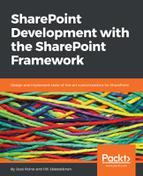With previous SharePoint frameworks, such as in the add-in model and the full-trust models, a developer would use Visual Studio to build and package everything in the project. As the code editor, this would often be a version released around the same time as the SharePoint version, such as Visual Studio 2013 together with SharePoint 2013.
For the SharePoint Framework, Microsoft envisioned that as things evolve rapidly and open source frameworks shift constantly, then the main development environment does not follow the pace set by Visual Studio. Visual Studio Code is a free, open source alternative to Visual Studio commercial editions from Microsoft, and it is the preferred integrated development environment for SharePoint Framework based projects.
Compared to a full and commercial version of Visual Studio, Visual Studio Code (or VS Code for short) is lightweight and quick to install. You can download the latest version of VS Code at https://code.visualstudio.com/, and it runs on Windows, macOS, and 64-bit Linux platforms. As it is much more lightweight, it lacks certain features of a full Integrated Development Environment (IDE) such as Visual Studio, but for the SharePoint Framework related work, it is more than sufficient. Think of VS Code as a glorified text editor that supports IntelliSense (providing automatic sensing of what you are writing and suggestions for methods, property names, and similar), several types of scripting and programming languages, debugging, source control, file management, and many third-party extensions.
VS Code also automatically updates itself, and you will frequently get a prompt for deploying a fresh update or forfeiting the update.
Compared to an IDE such as Visual Studio, VS Code's interface is fairly bareboned, to enhance productivity and to optimize code writing. In the following screenshot, you can see the toolbar on the far left, the open folder second, and a file being edited in the main area. As you can see in the following screenshot, VS Code does not have a toolbar but rather a command palette which opens up many options and features that are not immediately visible.

It's important to understand that VS Code works with files and folder structures, and it does not impose its own project or solution format that is typical for working with projects in Visual Studio.
VS Code is not only meant to be used with the SharePoint Framework it can be used for almost any type of development projects that include script-based languages, such as JavaScript, Python, PowerShell, HTML, and CSS.
You are free to choose any other text editor or IDE of your preference, as VS Code is not enforced in any way for developing SharePoint Framework solutions. The benefit of using VS Code, however, is that it's free, lightweight, and evolves very rapidly. Most sample code, tutorials, and guidance also assume that you are using VS Code so, as such, we strongly recommend you look at VS Code and consider using it as your primary editor for the SharePoint Framework solutions.
